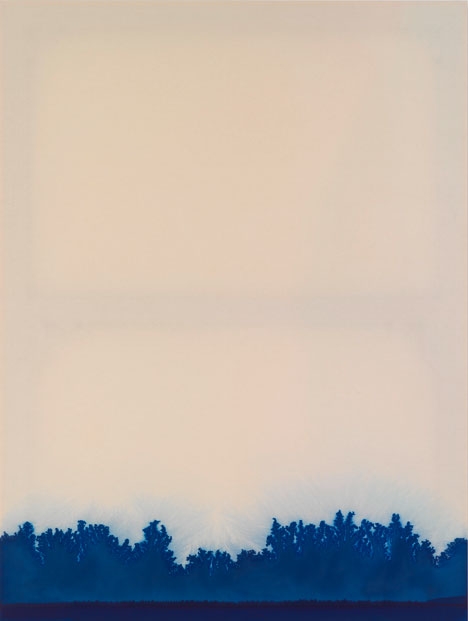Latifa Echakhch’s exhibition and its title, The Scene Takes Place, feel, in combination, at once tautologous and contradictory. Of course the scene takes place: indeed, scenery occupies the space, for confronting you on arrival is a stage set seen from the notional back of the theatre. But no scene is occurring on these flat grey-and-white-chequered boards.
And even though some of the painted wooden architectural arches have toppled or are frozen while toppling, held aloft by fine strings, and although lights with coloured gels have been plonked on the ground and three slack-stringed lyres lie abandoned, there are few signs that anything has taken place beyond the arrangement of this disarray. It is not a set transferred from a theatre and scuffed with use, but one that close inspection reveals to be pristine, not yet activated.
This installation, Tannhäuser (all works 2013), was inspired by Wieland Wagner’s spare Tannhäuser set for the Bayreuth Festival in 1955 and dominates the rectangular gallery space; even allowing for the idiosyncrasies of theatrical perspective, it makes for a condensed, narrow zone. The stage is abandoned, perhaps already obsolete before the opera could take place.
As a relic, or in a state of suspension, its most potent connotation is not to Tannhäuser, the legendary minstrel, but rather Richard Wagner’s legacy after the Second World War, the claims and counterclaims about his intentions and the afterlife of his works.
Ten unframed, two-metre-tall linen canvases hanging irregularly around the space break with the set’s scale and landscape. The bottom of each canvas is coloured by dark blue ink that has been absorbed upwards to create organic, corallike shapes, above which wispy tendrils of blue reach yet higher. Their titles, when read together, form a poetic account that begins with The scene takes place at the end of a torrent, without remembering how it all happened and continues with lines such as and then the moon appears between the branches. Thought deeply it will be the last landscape, but after a cloud, all turns upside down.
The canvases – the random outcomes of a self-generating process which the artist sets in motion by placing the linen in contact with the ink and before she stands aside to allow an uncontrolled result – resonate little in and of themselves until their titles associate them with the experience of light, sound, touch and smell.
Much of Echakhch’s work to date, such as For Each Stencil a Revolution (her 2007 installation of hundreds of sheets of carbon paper doused in solvent and bleeding blue onto the floor, its title a quotation from Yasser Arafat), has succeeded by generating friction between her art-historical precursors, particularly within Minimalism and Abstract Expressionism, and contemporary postcolonial cultural specificities, even if many of the latter are stereotypes rather than realities. (In this she productively avails of the expectations projected upon an artist born in Morocco, brought up in France and now living in Switzerland.)
By counterposing Tannhäuser and the ink paintings, she seems here to be interested in how figuration and association use different means to fill receptive frameworks. Within a relatively sparse exhibition, actions and histories alluded to have more impact than what is before us. Canvases are stained by ink that could write countless narratives, but it is the titles, seen at the remove of the list of works, that imbue the paintings with personal, fictional significance. And faced with an empty stage, our ears are pricked for these noises off.
This article was first published in the January & February 2014 issue.
